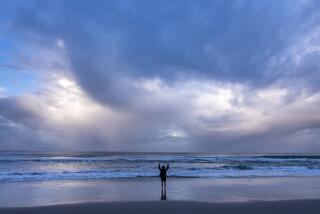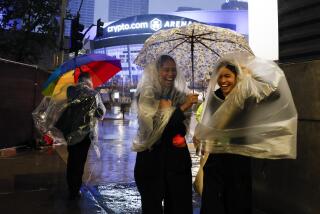Southern California’s water year has been nearly bone dry so far, making some history

Southern California is seeing one of its driest starts to the water year in decades.
Southern California is seeing one of its driest starts to the water year in decades, the National Weather Service said Wednesday.
Since the start of the water year on Oct. 1 through Dec. 31, downtown Los Angeles has received just 0.12 of an inch of rain. That is tied with 1962-63 for the fourth-driest start to a water year since record keeping began in 1877, the weather service said.
“The start of the storm season has been exceptionally dry,” said Ryan Kittell, forecaster with the National Weather Service in Oxnard. “It’s one of the driest in history.”
This year’s rainfall total is 3.91 inches below the normal 4.03 inches for the period in downtown L.A., making it just 3% of the typical rainfall. Forecasters said the driest first three months of a water year occurred during the 1903-04 season and the 1929-30 season, when just traces of rain were recorded.
It is also the 10th consecutive month that rainfall totals did not reach 0.5 of an inch in downtown Los Angeles.
Kittell said Southern California saw a similar dry start to the rainy season 15 years ago. Though the lack of rain is not unprecedented, it is “fairly exceptional,” he said.
“For downtown L.A., we have seven years where we have an exceptionally dry November and December,” Kittell said. “It doesn’t mean there will be a dry rest of the winter. The past has shown that we’ve had anywhere from 16 inches after we had trace of rain in November, December and January.”
The paltry amount of rainfall is part of a larger weather trend for Southern California: Over the last seven years, maximum temperatures during the fall have gotten hotter and there has been less rain.
October and November were the hottest in 122 years of record keeping for the region — a major turnaround from last year, when Northern California was battered by a series of “atmospheric river” storms that helped end the state’s five-year drought. When it was over, California’s northern Sierra Nevada experienced the wettest winter on record, with some ski resorts staying open through the summer.
“I think the moral of the story is that anything goes,” Kittell said. “Just because we have a dry November and December, it doesn’t mean we have a shutout for the rest of the winter.”
If the trend continues into spring, forecasters say California could see a light Sierra Nevada snowpack, a key source of water for the state during the dry summer. The state Department of Water Resources conducted the first of five scheduled 2018 snow surveys at Phillips Station in the Sierra on Wednesday morning.
Measurements at Phillips Station revealed a snow water equivalent of 0.4 of an inch — 3% of the average 11.3 inches that have been measured there this time of year since 1964. Snow water equivalent is the depth of water that theoretically would result if the entire snowpack melted.
“As we’re only a third of the way through California’s three wettest months, it’s far too early to draw any conclusions about what kind of season we’ll have this year,” said Department of Water Resources Director Grant Davis. “California’s great weather variability means we can go straight from a dry year to a wet year and back again to dry.”
Above average temperatures are expected to continue this week in Riverside, San Bernardino and San Diego counties, the weather service said, but next week a low-pressure trough over the Pacific will bring a gradually increasing chance of rain to those areas.
A cold front is also expected to bring rain to San Luis Obispo and Santa Barbara counties Wednesday afternoon into early Thursday. The front will likely weaken as it moves south, bringing a chance of light rain to Ventura County on Wednesday night into Thursday morning, according to the weather service.
For more California news follow me on Twitter: @sarahparvini
UPDATES:
12:50 p.m.: This article was updated with details on the snow survey.
This article was originally published at 10:25 a.m.
More to Read
Sign up for Essential California
The most important California stories and recommendations in your inbox every morning.
You may occasionally receive promotional content from the Los Angeles Times.











